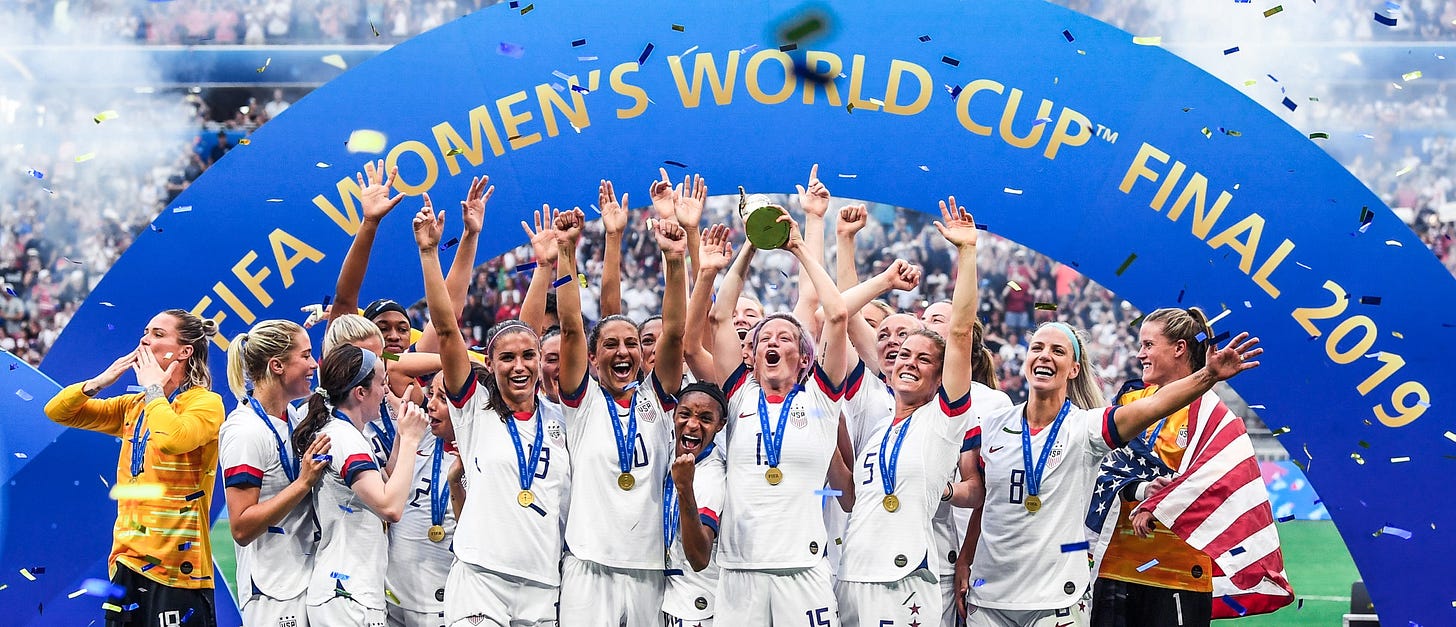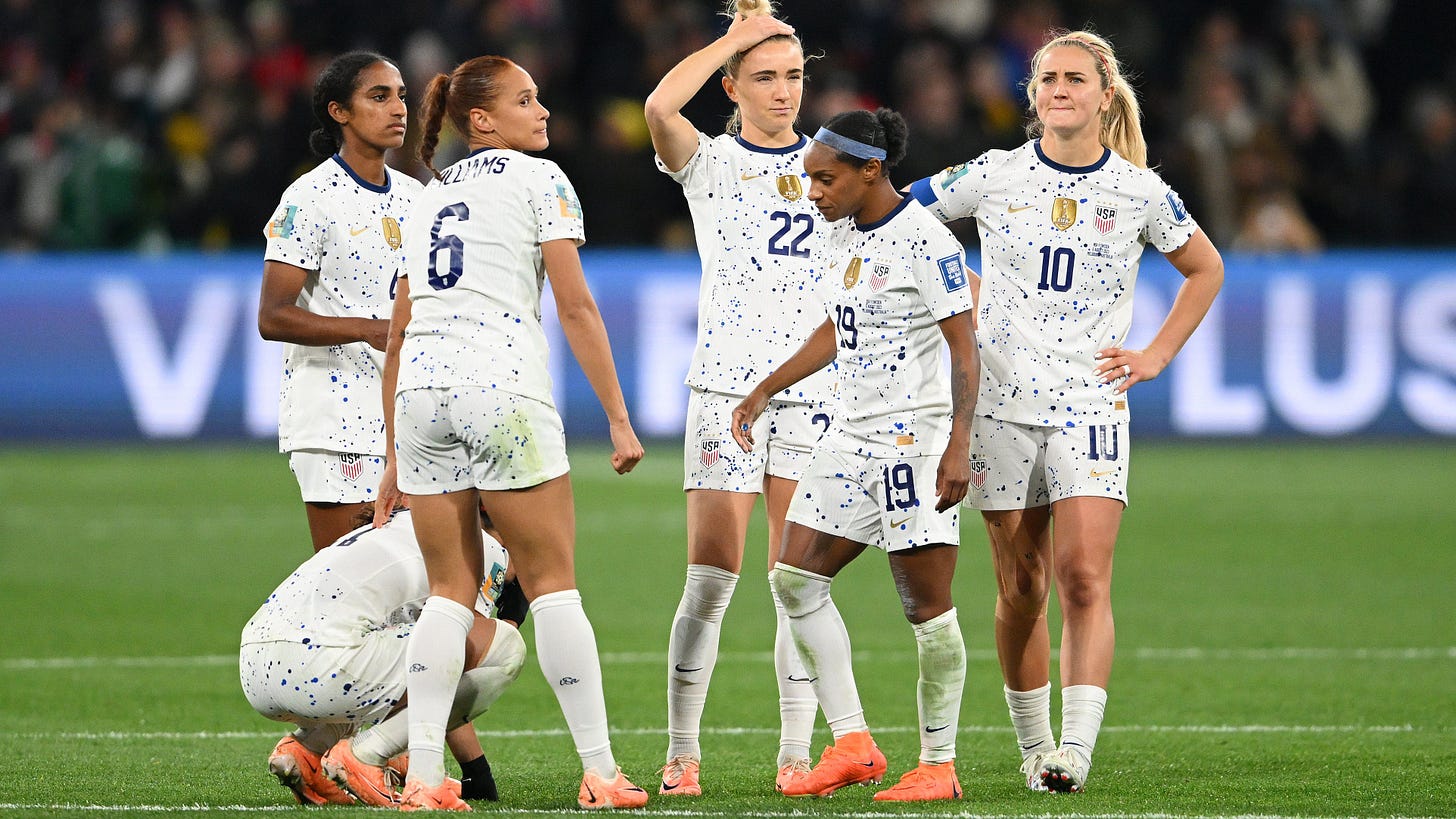Soccer is having a moment in America. We’ve been over that, and as everyone predicted, Messi has brought new excitement to MLS. Viva Miami, etc.
And yet, the most bankable quantity in American soccer finds itself at a low point. There is no photo like the one you see above, from 2019.
Instead, the enduring image this year is more like:
Stunned, heartbroken, and a little confused. This isn’t normal. We’re not used to being in this position.
The U.S. Women’s National Team crashed out of the World Cup in the Round of 16, its earliest exit in history. Were it not for the grace of the right post, they might not have made it that far.
And so it was only fair that a right post ended their run against perennial nemesis Sweden. The U.S. played by far its best game of the tournament, but it wasn’t enough.
Even the winning PK from Sweden was maddeningly close, taking some time on VR to confirm this was a goal:
So ended a dominant run for the USWNT.
Off We Go
The disappointment punctuated what had been a shaky run, drawing fierce criticism from those like Carli Lloyd, who — after the team barely made it out of the group stage with a razor-tight 0-0 draw to Portugal — said things like:
“Today was uninspiring. Disappointing. They don’t look fit. They’re playing as individuals and the tactics are too predictable… (They're) lucky to not be going home right now… I’m just not seeing the passion.”
I’m not qualified to offer worthwhile tactical punditry myself, so I’ll take at their word the many other pundits and experts who’ve been critical of since-departed coach Vlatko Andonovski, but it seems to me as if the biggest problem here might’ve just been the injury bug.
We generally agree across sports that that makes for a lame excuse, but sometimes it’s true.
Here, we had four top-flight starters — including defender and team captain Becky Sauerbrunn, as well as some sorely missed firepower in the attack, Mallory Swanson and Caterina Macario — missing from a roster that lacked the depth to weather the losses.
Stars at the tail ends of their careers — Alex Morgan, now 34, and Megan Rapinoe, 38 — couldn’t make an impact in the absence of those named above, which led to a “We’re between eras” narrative that might’ve been minimized had those players not been asked to do more than they could at this point.
The next era, in the form of players like Swanson and Macario, as well as others like Alyssa Thompson and Trinity Rodman, seems like it might already be here. Maybe they just weren’t ready yet.
Because then there’s the other part. The part that should go without saying, but bears underlining — not because the USWNT deserves a pass, but because it’s context.
It’s really hard to three-peat when you’re playing for a title every year. It’s something close to impossible when you’re playing for it every four.
The aspiration was lofty. There’s a reason it’s never been done, by men or women, and won’t be anytime soon.
Jargon Corner
“Dominance” is a tricky term to wrap your head around. It’s usually applied to a champion retroactively, and it sticks after people have forgotten the games along the way.
The 2016-17 Warriors? Dominant. Lost a single game in those entire playoffs, and that was in the Finals, to what was probably LeBron’s best team in Cleveland.
They went on to repeat the next year, which adds to the dominance label, but the All Fields faithful will recall from just last week that the 2017-18 team — even though they actually swept the Cavs in those Finals — was not quite so dominant.
They didn’t finish with the best record in their conference, and they went down 3-2 to the Rockets. Could’ve easily lost. They just didn’t.
Rarely is there a winner of much of anything who wasn’t challenged along the way. That’s part of what we like about sports. A good roster doesn’t do it. You have to actually play the games.
And both of the last two times the USWNT did win the World Cup, believe you me, they were challenged.
They very nearly lost, on multiple occasions, because this is soccer and that can happen. It’s a game of close margins. Even a better team can be tested, and yes, lose.
This year, the team seemed to be running on more good luck than bad. This was not a juggernaut who fell in a shock upset. This was a team whose borrowed time ran out.
Women’s sports in general, and certainly soccer, have come a long way since the tournament’s first edition in 1991.
Going back further than that, many of the countries who now compete for the World Cup had decades-long bans on women playing soccer at all, most of which were only lifted in the 70s — around the same time that Title IX became law in America.
Stunting the sport’s growth was nothing short of systematic and global.
Now, 50 years later, the state of the game is something to celebrate.
Spain has never won the women’s tournament before, despite its success on the men’s side.
I’m generally of the mind that a first-time champion is a good thing for a sport, and see no reason that doesn’t hold here too.
Women’s soccer is thriving. Soccer is thriving in America.
Fans here stateside would like to see us add, more definitively, that “American soccer is thriving,” but will have to wait to do so.
The women’s side will be just fine. If I had to guess, they’ll be back and favored to win the next World Cup.
As for the men… well. There’s a bit more work to be done there. Shame we can’t just send our new king of Miami out there.
No competitor should ever be satisfied with failure. It’s fine to be disappointed in how things went this year.
But it would be silly to think that means the U.S. is suddenly out of the picture.
Redeem Team, anyone?






Spot on about the "injury bug." Me thinks it is a transition time for the USWNT and they may benefit from a clean slate of coaches/leaders. Always enjoyable reading, MH!